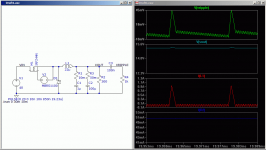I wouldn't cal 30mV peaks an issue with modern opamps.
Design by opinion.
To round this up, heres a simplified simulation of using a 22uH inductor at 52kHz in buck-configuration with parameters set:
VIN: 40V
VOUT: 15V
ILOAD: 50mA
Filtering is done by 1 MLCC 1uF + some random 100uF elyt capacitor, resulting in a 50mV ripple after filtering or 0.05% of VOUT.
I don't know the values used on the chinese boards but i suspect it's not less than 100uF.
This is then feed into an LDO with filtering.. before the opamp (with filtering as well).
Spice is attached.
VIN: 40V
VOUT: 15V
ILOAD: 50mA
Filtering is done by 1 MLCC 1uF + some random 100uF elyt capacitor, resulting in a 50mV ripple after filtering or 0.05% of VOUT.
I don't know the values used on the chinese boards but i suspect it's not less than 100uF.
This is then feed into an LDO with filtering.. before the opamp (with filtering as well).
Spice is attached.
Attachments
Compared to a buck circuit with additional filtering at the output + LDO and LC/RC filtering.
Actual implementation for 3255 with LM5017 (up to 100V) generating +/-12V in fly-bluck for AFE and input stage:
Are we using -ive voltage rails in the evm board? I am not able to find any "-12v" on the schematic of 3255 evm board, only able to see the +12 etc.
== I am not able to find any "-12v" on the schematic of 3255 evm board, only able to see the +12 etc. ===
Exact ... It's looks like a to economize on safety-matches 🙂
Exact ... It's looks like a to economize on safety-matches 🙂
== Or with ac coupling, it's entirely unnecessary...==
- Yep ... But... Best capacitor in signal path - it are NO capacitor ... :-/
- Yep ... But... Best capacitor in signal path - it are NO capacitor ... :-/
Let's really not go there as that's more a philosophy than a real design constraint, okay? As it stands, the evm gets pretty great performance with a.c. coupling and ancient opamps used as input buffers. 🙂
Edit to add you'll need to have it a.c. coupled before the 3255 anyhow as that's on single supply, so its a matter of where rather than if.
Edit to add you'll need to have it a.c. coupled before the 3255 anyhow as that's on single supply, so its a matter of where rather than if.
Last edited:
No, this is my own implementation with symmetrical opamp supply. The EVM is using single supply.
== Or with ac coupling, it's entirely unnecessary...==
- Yep ... But... Best capacitor in signal path - it are NO capacitor ... :-/
can the instruments show the presence of a capacitor? or only ears?
No, this is my own implementation with symmetrical opamp supply. The EVM is using single supply.
is the cost-effectiveness ratio good?
or is it a sporting interest?
Last edited:
I haven't calculated against the EVM implementation, but yes, the coupled inductor (Coilcraft) is more expensive then standard (random) inductors. Beside that, our implementation is much smaller (170mm^2)and works up to 100V. As we tested several AFE (analog frontent) designs, +/- supply was/is nice to have. Due to high frequency, filtering is much smaller (if needed) and can be done with ferrites and MLCC. I'll reuse the design for other projects. It's also easy to adapt to an isolated AUX supply.
Long story short, it is sporting interest. 🙂
Long story short, it is sporting interest. 🙂
No, this is my own implementation with symmetrical opamp supply. The EVM is using single supply.
Could you please tell how did you generated the dual rail voltages (+/-) for the analog front end. And what filtering you did on those rails for the switching noise.
Design is straigt from datasheet (LM5017) in "minimum ripple configuration" (Page 13 Table 1 Type 3).
Just follow 8.2.2 Detailed Design Procedure (Page 18). Additional filtering depends on load current and switching frequency.
Just follow 8.2.2 Detailed Design Procedure (Page 18). Additional filtering depends on load current and switching frequency.
Just want to hear what people think of Original EVM vs. Blue YJ vs. 3e boards.
Are the Original EVM still the best performers? Or is there little difference?
Are the Original EVM still the best performers? Or is there little difference?
- Home
- Amplifiers
- Class D
- TI TPA3255EVM

